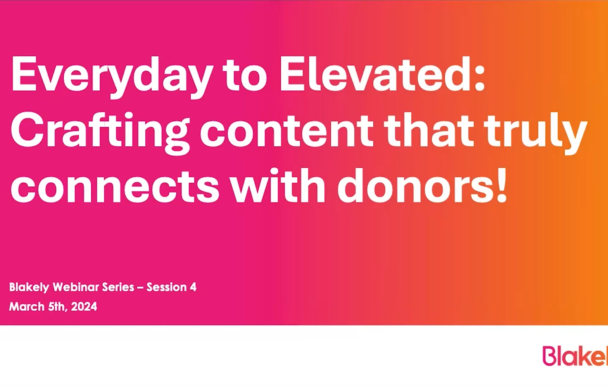TOP 3 “A-HA!” MOMENTS FROM NIO SUMMIT 2019
A few members of the Blakely fam headed to Denver for The Nonprofit Innovation & Optimization Summit (NIO Summit) a few weeks back and it did not disappoint. While the NIO Summit was mainly about digital fundraising, there were also some great sessions to help your fundraising program overall. We brought back our top 3 “a-ha!” moments to help take your fundraising and digital marketing to the next level.
#1 – Content is no longer King (via Kesheyl van Schilt, President & CEO)
Wait, what? Considering we had just hosted a session for our clients on Content is Queen, my ears perked up when content marketer Ross Simmonds from Hustle & Grind said, “Content is King is dead”. And he didn’t mean that he was going to replace King with Queen.
The point he was making is that the lifecycle of an article (content) ended when you published. Today, it begins when you publish (think HuffPost). And this is true for individual fundraising. For years we have been talking to our clients about the donor journey but more and more recently, we have been talking to them about the content journey that supports this. Valuable, relevant content that your supporters want to read and engage with again and again and in different ways.
Gone are the days where you publish a story once. Today, we can use the rich stories we collect over and over again, telling the story from different angles and adapting it for different audiences. Simmonds noted there were three parts to think about – discover, create and distribute. Distribution in Simmonds’ world is the donor journey in ours. As we continue to learn from our friends in the for-profit marketing world, we can apply it in the non-profit space to engage our supporters effectively.
#2 – The (copy)writing isn’t always on the wall (via Shannon Parker, Art Director)
As a creative, the session I was looking forward to the most was one on copywriting (and I was not disappointed!). Amy Harrison, copywriter, consultant & speaker at Write With Influence specializes in persuasive copywriting and shared some tips on how to make your message more compelling.
One key message was that garnering an emotional response and in turn, an investment, from your donor is done by describing the symptoms rather than the problem.
Showing the cost of doing nothing using emotions like fear & loss works well here. The cost of doing nothing could include potential NEW symptoms. Showing the cost of doing nothing can combat the donor’s reaction to the ‘cost to them’ (a.k.a. the donation amount ask).
Amy said you need to show the value of the solution – tell a compelling story, a moment of transformation, citing a specific place and time. In my opinion, this adds to the authenticity and makes the moment feel less ethereal to the donor. What is most important is to use stories to give clarity and provide detail to help amplify the solution.
#3 – Don’t torture your data! (via Oliver Hibbs, Director, Digital)
Michael Aagaard, world renowned conversion optimizer, spoke on how, as a marketer, it is important to overcome confirmation bias.
What is confirmation bias, you may ask? Confirmation bias is the tendency to search for, interpret, favor, and recall information in a way that affirms one’s prior beliefs or hypotheses.
As marketers we have all probably done this. How many times have you adjusted, reviewed, or rerun analysis looking for a statistic that backs up your original hypothesis? If you believe that a certain issue exists, you will discard evidence against that belief and focus on finding evidence that supports it. Michael called this ‘torturing the data’, and he’s right – Don’t torture the data! Let it speak for itself.
This happens so much these days, and not just in marketing; people block others in social media that we don’t agree with or we ignore news sources that don’t align with our views.
It’s important that, as marketers, we keep our minds open to what the evidence suggests. With the increased capability of technology, our data collection, reporting and analysis abilities have increased tremendously, but if we do not look at the evidence with an open mind, we will miss the key insights that help us build our programs.
As Michael mentioned in his presentation, we need to accept that you could be wrong in your hypothesis. And that is ok! We have the ability with the nimbleness of digital media to challenge our hypothesis by testing and learning what our audiences are really engaging with. This feedback is a vital part of creating marketing programs that resonate with our audiences.
We hope these ‘a-ha!’ moments struck a cord with you as much as they did with us and can help you take your fundraising and digital marketing to the next level.








